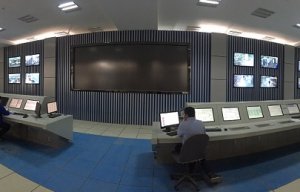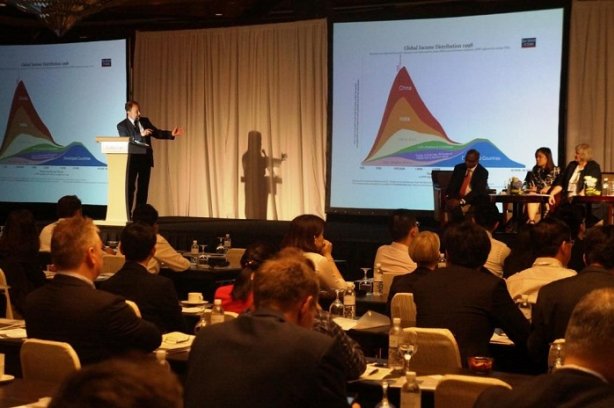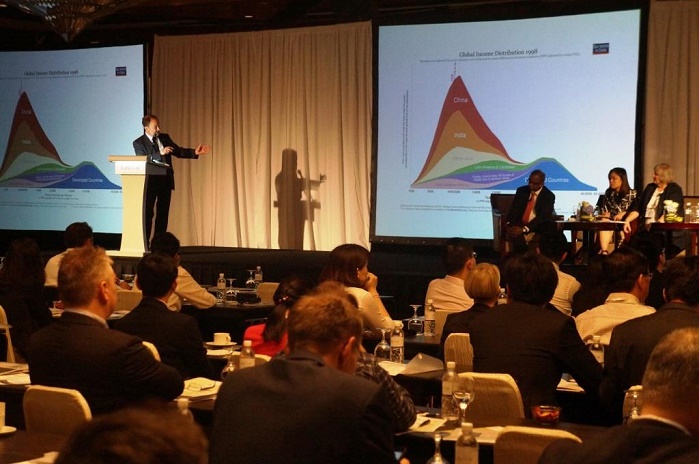
Jushi expansion in full swing
Expert insight from David Dodwell on China's push to take a larger role in global affairs and trade.

1st March 2018
Innovation in Textiles
|
Brussels
 In the build up to Outlook Asia, which takes place from 14-15 March 2018 in Singapore, EDANA’s General Manager Pierre Wiertz caught up with one of the key speakers, David Dodwell, Executive Director of the Hong Kong-APEC Trade Policy Study Group, to talk over Beijing's strategy to underline China's push to take a larger role in global affairs with a China-centered trading network.
In the build up to Outlook Asia, which takes place from 14-15 March 2018 in Singapore, EDANA’s General Manager Pierre Wiertz caught up with one of the key speakers, David Dodwell, Executive Director of the Hong Kong-APEC Trade Policy Study Group, to talk over Beijing's strategy to underline China's push to take a larger role in global affairs with a China-centered trading network.
David Dodwell is Chief Executive of Strategic Access Limited. A veteran Financial Times journalist and expert on international business, global trade and economic and political developments, particularly in Hong Kong and China, he founded the company in 2005.
Pierre Wiertz: You are joining us at Outlook to examine the One Belt and One Road (OBOR), initiative. What do you think is the biggest single driver of this programme?
David Dowell: As a child growing up in the UK, my school classroom had a map of the world on it, and guess what: the UK was at the centre of the map, with the rest of the world neatly ranged east and west of us. A school kid in the US would no doubt have a similar map on the classroom wall – and guess what: the US would be emphatically at the centre. I don’t know whether Japanese children have similar world maps, but at the highest level, I believe the Belt and Road initiative is an attempt to define China’s place in the world – to describe the world as it would be arrayed to a Chinese school pupil, and more broadly to Chinese people.
As the Government moves away from the 1960s-1970s decades of introversion and disconnection with the rest of the world economy, the Belt and Road initiative is also an effort to define future priorities – most of them geographic and economic, but some of them strategic and political – on a very long-time frame. It is a vision for the coming 100 years, rather than a vision of immediate business or economic priorities.
PW: OBOR comprises more than impressive infrastructure projects for physical connections, it aims also at economic cooperation and policy coordination and even targets social and cultural cooperation. Which will be the more difficult to achieve?
DD: Given the suspicions harboured by many around the world over China’s ambitions as it becomes more powerful and internationally influential, I think all are going to be more or less difficult to achieve. But this is a very long-term vision, underpinned by deep patience – something not often apparent in the politics of western governments. However, from my experience, among these various challenges, it is perhaps the policy coordination that will prove the toughest.
After decades of building their own institutions without necessary reference to international practice, they have developed a wide range of distinct institutional practices that are deeply embedded that will prove tough to reconcile with international practices – from a political system distinct from western democratic models, to a legal system not based on common law, and so on. Reconciling these differences after more than six decades since creation of the post-World War 2 Bretton Woods institutions during which US institutional practices have tended to prevail is not going to be easy.

PW: How have the other trading blocs reacted? How soon do you think we will see counter measures? Indeed, have we seen a shift at all from mere awareness to a formulated and coordinated response?
DD: I don’t see the Belt and Road initiative as any kind of “trading bloc”. It is more a way of perceiving the world, and of setting trade and investment priorities, with infrastructure-building seen as central at these early stages of development. As such, there is very little to push back against. The Belt and Road more or less provides a snapshot of the status quo and shows where China perceives its economic and strategic priorities. Of the 60+ economies embraced by the Belt and Road, most are simply grouped around the status quo: 28 of the economies comprise the European Union, where the development of trade and investment links continues; a further 10 comprise ASEAN, which again has well-established networks of economic relationships with China; China’s relationship with India remains “sui generis”, as does that with “Russia”.
The distinctive addition is the “stans” – the economies from Kazakhstan and Pakistan across to Uzbekistan and Georgia. Here, China’s interest is also distinct and “sui generis” – based on a concern to pre-empt destabilisation of China’s far west due to turbulence across large parts of Central Asia.
PW: China’s rapid development has engendered unsustainable levels of pollution. How green is OBOR? Does it not perpetuate a carbon - and pollution- intensive economic model? Great “green claims” have been made but no clear policy guidelines for sustainability requirements have been released.
DD: This is a very good question, and it is far too early to provide a clear or reliable answer. The challenges facing the global economy arising from China’s determination first to become manufacturer to the world (assuming responsibility for pollution that used to be generated in Europe and the US) and second to add 600m people to the world’s population of high-consuming middle classes, are formidable.
About the best we can say at present is that Xi Jinping’s administration has got the message: on current technologies, we are putting unacceptable pressures on global resources, and uncalculated strain on the globe’s environment. At present, his administration has begun systematically to talk not about growth, but about “quality growth”, which for the first-time factors in the environmental harm currently being inflicted and commits to policies intended to re mediate. Only time will tell how effectively they can mitigate the harm currently being done.
PW: And what of the geopolitical impact in Asia? China has been very strategic in the way it has been investing and, building relationships but also very overt in it’s plans for expansion and influence.
DD: The geopolitical impact of China’s emergence as a huge economic power increasingly interested to assert a global role commensurate with its size is already huge and will grow steadily. This in part explains increasingly petulant commentary from the US, and anxieties expressed by many economies across the Asia Pacific as the US’s “Pax Americana” becomes less ubiquitous.
Of comfort to the most anxious is that fact that the US’s ability to influence is as much based on “soft power” and long-standing alliances as on hard military power, and China is still far from being able to claim a similar trusted alliance network, or anything near the US’s soft power across the Asia-Pacific region. But of course, this can change over time, and probably will.
PW: Which proposed infrastructure project excites you most?
DD: Rather than identify any specific infrastructure project, what excites me most is China’s quite explicit rejection of the aid policies adopted by the rich western economies after the establishment of the Bretton Woods institutions. Instead it believes the best aid they can provide to developing economies is investment in stronger infrastructure – whether roads, power and clean water, or strong internet infrastructures.
The Belt and Road focus on infrastructure is a very specific embodiment of this fundamentally different aid and development strategy – effectively saying that it is better to give people fishing rods, rather than simply send them fish.
PW: And, conversely, which do you think the most problematic?
DD: Big infrastructure is frequently problematic and controversial, triggering numerous unintended consequences that can be harmful to the environment or to specific communities. Already, arguments have arisen in Pakistan and Myanmar over such projects. So too in Sri Lanka have concerns been voiced about burdening economies with unsustainable levels of debt. Sensitivity over potentially harmful unintended consequences will be essential if China’s Belt and Road initiative is to bring the benefits intended.
PW: David, many thanks for taking the time to talk with us today, I look forward to hearing more on this at your presentation in Singapore.
DD: A pleasure, thank you.

Business intelligence for the fibre, textiles and apparel industries: technologies, innovations, markets, investments, trade policy, sourcing, strategy...
Find out more